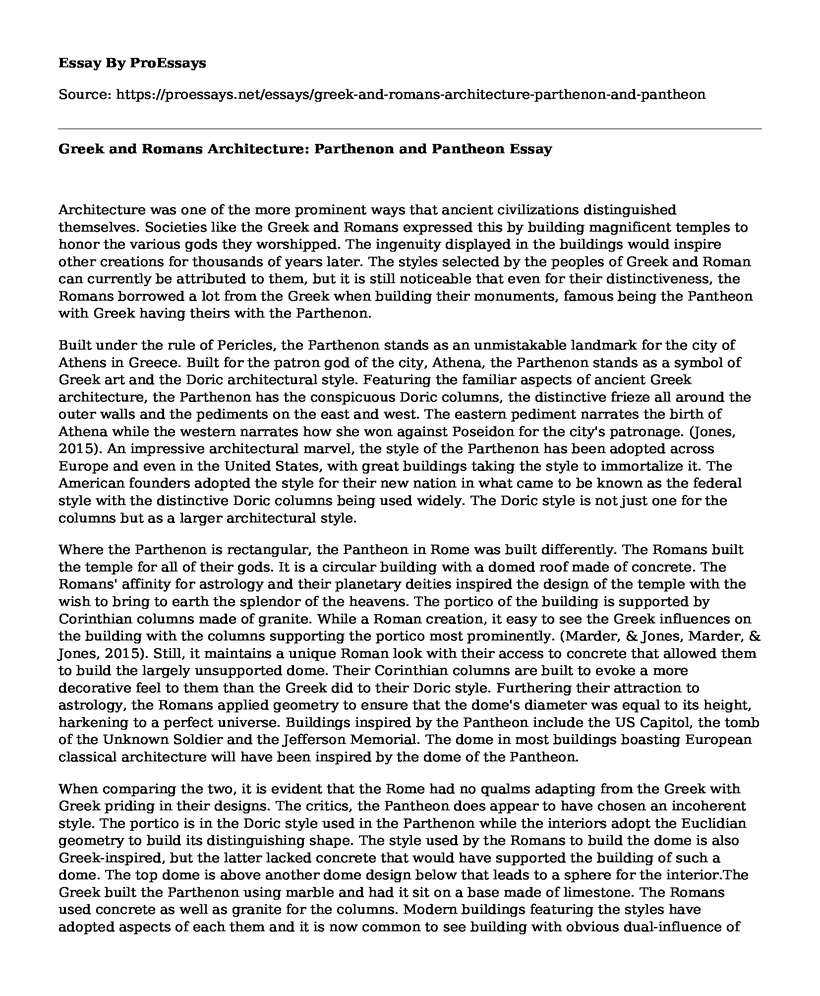Architecture was one of the more prominent ways that ancient civilizations distinguished themselves. Societies like the Greek and Romans expressed this by building magnificent temples to honor the various gods they worshipped. The ingenuity displayed in the buildings would inspire other creations for thousands of years later. The styles selected by the peoples of Greek and Roman can currently be attributed to them, but it is still noticeable that even for their distinctiveness, the Romans borrowed a lot from the Greek when building their monuments, famous being the Pantheon with Greek having theirs with the Parthenon.
Built under the rule of Pericles, the Parthenon stands as an unmistakable landmark for the city of Athens in Greece. Built for the patron god of the city, Athena, the Parthenon stands as a symbol of Greek art and the Doric architectural style. Featuring the familiar aspects of ancient Greek architecture, the Parthenon has the conspicuous Doric columns, the distinctive frieze all around the outer walls and the pediments on the east and west. The eastern pediment narrates the birth of Athena while the western narrates how she won against Poseidon for the city's patronage. (Jones, 2015). An impressive architectural marvel, the style of the Parthenon has been adopted across Europe and even in the United States, with great buildings taking the style to immortalize it. The American founders adopted the style for their new nation in what came to be known as the federal style with the distinctive Doric columns being used widely. The Doric style is not just one for the columns but as a larger architectural style.
Where the Parthenon is rectangular, the Pantheon in Rome was built differently. The Romans built the temple for all of their gods. It is a circular building with a domed roof made of concrete. The Romans' affinity for astrology and their planetary deities inspired the design of the temple with the wish to bring to earth the splendor of the heavens. The portico of the building is supported by Corinthian columns made of granite. While a Roman creation, it easy to see the Greek influences on the building with the columns supporting the portico most prominently. (Marder, & Jones, Marder, & Jones, 2015). Still, it maintains a unique Roman look with their access to concrete that allowed them to build the largely unsupported dome. Their Corinthian columns are built to evoke a more decorative feel to them than the Greek did to their Doric style. Furthering their attraction to astrology, the Romans applied geometry to ensure that the dome's diameter was equal to its height, harkening to a perfect universe. Buildings inspired by the Pantheon include the US Capitol, the tomb of the Unknown Soldier and the Jefferson Memorial. The dome in most buildings boasting European classical architecture will have been inspired by the dome of the Pantheon.
When comparing the two, it is evident that the Rome had no qualms adapting from the Greek with Greek priding in their designs. The critics, the Pantheon does appear to have chosen an incoherent style. The portico is in the Doric style used in the Parthenon while the interiors adopt the Euclidian geometry to build its distinguishing shape. The style used by the Romans to build the dome is also Greek-inspired, but the latter lacked concrete that would have supported the building of such a dome. The top dome is above another dome design below that leads to a sphere for the interior.The Greek built the Parthenon using marble and had it sit on a base made of limestone. The Romans used concrete as well as granite for the columns. Modern buildings featuring the styles have adopted aspects of each them and it is now common to see building with obvious dual-influence of the two temples. The Parthenon and the Pantheon do indeed stand to the ingenuity of their builders and are worthy of the high positions they hold in history.
References
Marder, T. A., & Jones, M. W. (2015). The Pantheon: from Antiquity to the present. Cambridge University Press.
Jones, M. W. (2015). Ancient Architecture and Mathematics: methodology and the Doric temple. In Architecture and Mathematics from Antiquity to the Future (pp. 271-295). Birkhauser, Cham.
Cite this page
Greek and Romans Architecture: Parthenon and Pantheon . (2022, Mar 29). Retrieved from https://proessays.net/essays/greek-and-romans-architecture-parthenon-and-pantheon
If you are the original author of this essay and no longer wish to have it published on the ProEssays website, please click below to request its removal:
- Comic Assignment: The Old Man And His Grandchild
- Essay Example on the Departed: Studying Philosophical Aspects Through Deontology
- Youth & Digital Media: Impact of Viewing Behavior - Essay Sample
- Trolling: Definition, Prevalence and Effects - Essay Sample
- Disney's Exaggerated Body Imaging: An Analysis of Male and Female Characters - Essay Sample
- Fashion Marketing: Creative Advertising of Textiles & Garments - Essay Sample
- Gossip Girl - Essay Sample







